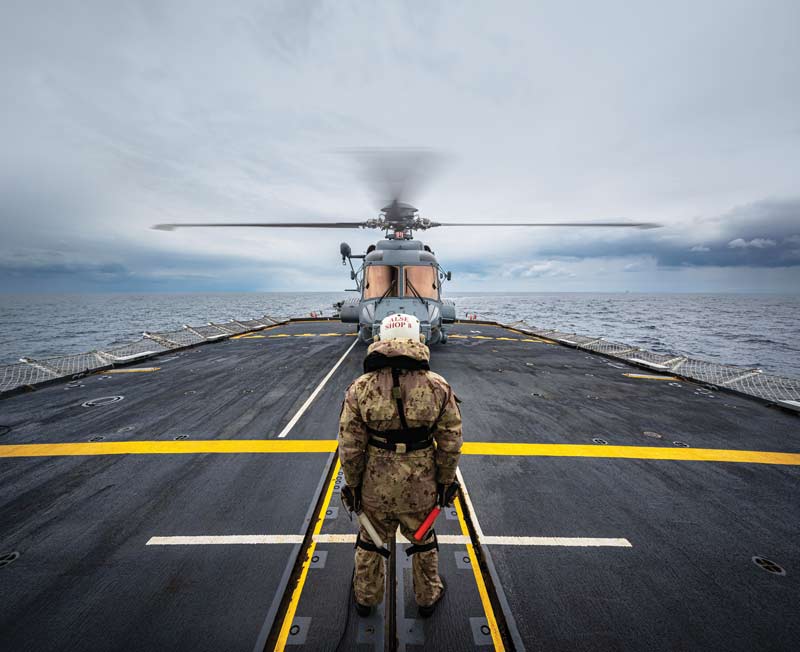
A Royal Canadian Air Force CH-148 Cyclone readies for takeoff during operations in the Mediterranean Sea in March 2022.[Corporal Braden Trudeau/CAF]
Canada’s military has long been plagued with procurement problems. It took 30 years to go from the Progressive Conservative’s announcement to order replacement helicopters for the aging CH-124 Sea King to when the last of that venerable aircraft retired. And it will be nearly a decade until the succeeding fleet is fully operational.
That lengthy drama began in 1993 when Jean Chretien’s Liberals won the largest majority in the country’s history. The Conservative government that preceded his, first under Brian Mulroney then Kim Campbell, had concluded a long competition to find a Sea King replacement.
Its choice was the EH-101, built in Britain by AgustaWestland. The Tories had ordered 35 of the helicopters in 1987, but Chretien had campaigned, in part, on a promise to cancel the contract because, he said, they were too elaborate and expensive.
Not long after this, a search was initiated to replace the Sea Kings; it took 10 years to get to the preliminary approval stage with a civilian Sikorsky design (the S-92). The government intended to buy the S-92 as a military helicopter, dubbed the CH-148 Cyclone, with major modifications that would enable it to perform at sea in rough weather, with ship-borne landing pads that danced and jumped with every wave that crashed against a ship’s hull.
The first Cyclone was delivered in June 2015, but continuing delays—caused mostly by the civilian-to-military-purpose conversion—mean Canada still doesn’t have all the helicopters it ordered; the navy is awaiting the final two aircraft now. Thus, it took 30 years from the cancellation of the EH-101 to receive the penultimate CH-148s.
During most of that time, the Sea Kings continued to fly even though maintenance costs grew yearly, as did downtime due to maintenance, which resulted in mission delays.
So, how has the CH-148 fared since it went into service? Constant problems, some of them serious, have plagued the aircraft. For example, early this past February, the CBC’s Murray Brewster reported that some Cyclone main rotor blades were “defective [and] could rip apart in flight.” Known as “debonding,” it’s described as when “the skin of the blade peels off while the helicopter is in the air.”
But this is only the latest in a growing list of problems with the CH-148. Others? The estimated life-cycle cost of the Cyclone has risen from $14.8 billion to $15.9 billion, all while its weapons systems are becoming rapidly obsolete. Then there was the April 2020 crash of a Cyclone into the Ionian Sea, apparently at full speed, that took the lives of six Canadian sailors. A lawsuit against Sikorsky filed by the families of the dead crew alleges that the incident was caused by a failure of the aircraft’s flight-control system. Sikorsky denies the allegations.
The root of the problem, however, lies in the initial decision to purchase the civilian S-92 and convert it to military use. The latter is much harder on any vehicle—land, air or sea—than the former. That’s why military trucks are large, with strong tires, robust frames and engines, and designed to run well in all types of weather and no matter the condition of the road, or lack thereof, or the circumstances surrounding them. The same essential characteristics are necessary for military helicopters. There are no exceptions, and such designs aren’t cheap.
In the case of replacing the Sea King after Chretien’s decision to cancel the EH-101 contract—which cost the government $478 million in penalties, by the way—there were several viable off-the-shelf candidates that could have been selected. For example, the U.S.-built Black Hawk is now flown by 34 countries.
Perhaps that family of utility military helicopter was considered too expensive or didn’t have the carrying capacity of the S-92/CH-148 aircraft. But, when reflecting on the last 30 years and seeing how difficult the conversion from civilian to military configuration was, some people in Ottawa might well question the decision to buy the Cyclone in the first place.
When it comes to military procurement, the proverb “better safe than sorry” means all that much more.
Advertisement



















